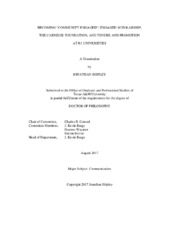| dc.description.abstract | In 2006 the Carnegie Foundation for the Advancement of Teaching created a new elective classification for institutions of higher education: that of “Community Engagement”. It was the first voluntary classification, and since its release the number of campuses that have been approved as “engaged” institutions has risen to 359 within the United States, and more administrations apply with every iteration. Of those, 61 are R1 institutions, fully 53% of current R1 schools. This dissertation looks at the Carnegie Foundation and its history, including reputation management strategies, the Community Engagement Classification, and the rhetorical strategies implemented in its design. It is also an analysis of public tenure and promotion documents at R1 universities, specifically in how they treat the concepts of engaged scholarship and community engagement.
The Carnegie Foundation actively shapes their reputation and organizational history in order to appear as credible as possible. Currently one of their key accomplishments is that of the Carnegie Classifications of Higher Education, and their identity has become inextricably tied to the system. The release of the new classification has implications on how the Foundation itself is viewed and interacted with. Subsequently, high adoption of the new classification was desirable, not only to focus attention on community engagement (one goal of the release), but also to maintain the credibility of Carnegie and its system of classification. The implementation of strategic ambiguity has aided in the overall rate of adoption, but it may be a problem for the Foundation in the future.
One of the metrics utilized in the application for the Community Engagement Classification is that of tenure and promotion policies. They play a key factor in whether faculty are encouraged and enabled to reach out to the community as a part of their professional role. R1 universities, even those currently classified as Community Engagement campuses, continue to struggle to validate practices that treat the community as anything more than participants in “discovery” research, a finding that may have significant long-term impacts on both the future of engaged scholarship and the validity of the Carnegie Foundation and their ability to classify institutions of higher education. | en |


